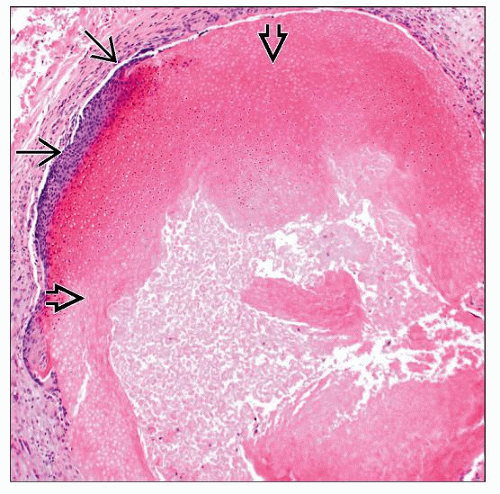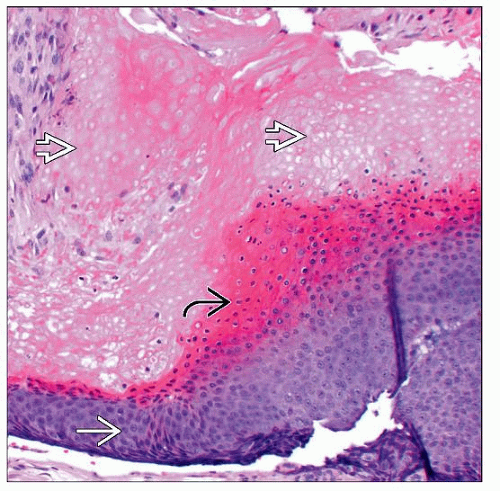Pilomatrixoma and Pilomatrical Carcinoma
Senait W. Dyson, MD
David Cassarino, MD, PhD
Key Facts
Terminology
Calcifying epithelioma of Malherbe
Etiology/Pathogenesis
Derived from matrix of hair follicle
Clinical Issues
Pilomatrixoma
Relatively common, rubbery to hard solitary tumor mostly seen in young children
Head and neck and upper limbs
Pilomatrical carcinoma
Very rare, solitary tumor of the elderly
Male predominance (M:F = 5:1)
Macroscopic Features
On gross sectioning, PMX often shows chalky material due to calcifications
Microscopic Pathology
Pilomatrixoma
Well-circumscribed, dermal to subcutaneous tumor with mixture of basaloid and shadow cells
Lesion often surrounded by fibrous connective tissue capsule
Dystrophic calcification is frequently seen
Foreign-body giant cell reaction surrounding tumor is common
Pilomatrical carcinoma
Ulcerated, asymmetrical, dermal to subcutaneous nodule
Poorly circumscribed, cellular, and infiltrative tumor
Numerous mitoses and tumor necrosis often present
TERMINOLOGY
Abbreviations
Pilomatrixoma (PMX)
Synonyms
Pilomatrixoma
Pilomatricoma
Calcifying epithelioma of Malherbe
Trichomatricoma
Pilomatrical carcinoma
Matrical carcinoma
Malignant pilomatrixoma
Pilomatrix carcinoma
Definitions
Pilomatrixoma
Benign dermal &/or subcutaneous tumor
Derived from matrical portion of hair follicle
Pilomatrical carcinoma
Malignant counterpart of pilomatrixoma
ETIOLOGY/PATHOGENESIS
Differentiation
Derived from matrix of hair follicle
Mutation in the CTNNB1 gene seen in both pilomatrixoma and pilomatrical carcinomas
CTNNB1 gene encodes β-catenin
Genetics
Rare cases are associated with myotonic dystrophy and Rubinstein-Taybi syndrome
Usually multiple pilomatrixomas present
Cysts of Gardner syndrome can show pilomatricoma-like changes
CLINICAL ISSUES
Epidemiology
Incidence
Pilomatrixoma
Relatively common
Pilomatrical carcinoma
Very rare
Age
Pilomatrixoma
Young children (1st and 2nd decade)
Rare in adults
Pilomatrical carcinoma
Elderly
Gender
Pilomatrixoma
No gender predilection
Pilomatrical carcinoma
Male predominance (M:F = 5:1)
Site
Pilomatrixoma and pilomatrical carcinoma
Head and neck and upper limbs










